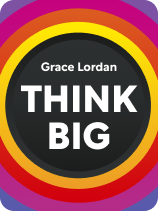

This article is an excerpt from the Shortform book guide to "Think Big" by Grace Lordan. Shortform has the world's best summaries and analyses of books you should be reading.
Like this article? Sign up for a free trial here.
What’s the key to transforming your life? How can little things add up to big achievements?
In Think Big, Grace Lordan explains how you can take small steps and build the future you want. One key is to go slow and steady. Another is to overcome the cognitive biases that often get in the way of your goals.
Continue reading for an overview of this practical and inspiring book that can propel you toward your ideal future.
Overview of Think Big (Grace Lordan)
In Think Big, Grace Lordan argues that most of us fail to transform our lives because we try to change too much too quickly. Instead, we must set a big goal, acknowledge that achieving it will take a few years, and then take the regular, small steps necessary to achieve it. Moreover, we must understand how to overcome the cognitive biases—the mental shortcuts that all humans take—that hinder us from achieving our goals.
Lordan works as an Associate Professor of Behavioral Science at the London School of Economics and advises the UK government on productivity. Think Big, which was published in 2021, is her first book.
We’ll first define what cognitive biases are and how your own (and others’) affect your life. Then, we’ll share Lordan’s advice on changing your life by identifying who you want to become, and how to recognize and work around both your cognitive biases and external obstacles.
What Are Cognitive Biases?
To understand the necessity of overcoming cognitive biases, we must first understand what they are. Lordan explains that, despite popular opinion, humans are not rational beings. Rather, we’re all subject to cognitive biases—systematic errors in thinking that occur when we process and interpret information in a way that differs from objective reality. These biases often lead us to make decisions that aren’t in our best interests long-term. (We’ll discuss how specific biases harm us later on.)
Cognitive biases affect the decision-making processes of all humans, so these biases necessarily affect your life. Lordan contends that most of the cognitive biases you’ll encounter are your own; so if you want to achieve your goals, you need to know what they are so that you can better work around them. You’ll also encounter others’ biases—and while you can’t control how they deal with those biases, you can learn how to work around the biases of any gatekeepers you encounter on your way to achieving your goal. (We’ll discuss how to do this in a later section.)
Plan for Who You Want to Be
Now that you understand how your cognitive biases are holding you back, how can you overcome them so you can transform your life? In this section, we’ll describe the first steps you must take: Know who you want to be, then create a plan for becoming that person. We’ll also discuss how to handle the specific biases that may arise as you start your journey.
Know Who You Want to Be
The first step to changing your life, Lordan argues, is to identify your ideal future self—which Lordan calls your “ME+” and which we’ll call your ideal self. Imagine a typical workday in the life of your ideal self—anywhere between two and 10 years from now. What is their job title and the field in which they work? What kinds of tasks fill up their day? If you’re uncertain about the former, focus on the latter, imagining what work tasks you’d love to do all day. Ideally, these tasks will feel significant—both in your own life and with regard to the impact you have on others—as we tend to try harder to achieve goals that we deem significant.
Make sure that the future self you envision reflects your true desires. Lordan cautions against falling victim to the cognitive bias called the ambiguity effect: a tendency to choose the option (goal) where you know the probability of a favorable outcome—even if you’re not as excited about that goal. Additionally, avoid the bandwagon effect—the tendency to do whatever the people around you are doing—and reactance bias—the rebellious instinct to stick with something specifically because others don’t like it.
Once you’ve identified your ideal self, Lordan contends that you must figure out what skills your ideal self has that you need to develop. Ask yourself: Why am I not currently able to be this ideal self? If you’re unsure, find some people whose jobs are similar to those of your ideal self, and determine what skills they use regularly that you lack. Pick three to five skills that you can reasonably develop: You should be able to develop them by working on them a little bit every week, and developing them shouldn’t cost prohibitive amounts of money.
Practice New Skills
Lordan explains that once you know what skills you need to develop to become your ideal self, you need to regularly practice them. This is because becoming your ideal self requires that you master the skills you identified—and to master them, you must practice them until they become so ingrained that they’re habitual. Start by writing the skills down somewhere you’ll regularly encounter them: Our saliency bias dictates that we pay more attention to information that’s conspicuous. Then, Lordan recommends that you plan how you’ll regularly practice these skills. First, look at your current job: How could you adjust your responsibilities so that you spend more time developing the skills you desire? Second, decide how you’ll improve upon these skills in your personal time.
Build Relationships
Lordan asserts that you must also plan how you’ll develop the relationships that will help you become your ideal self. Start with the people you already know: Every month, ask someone you know for help on your journey to becoming your ideal self. Lordan recommends starting with people you know at work, as they’ll likely have the relevant expertise.
Additionally, every month, reach out to people you don’t know who could help you—like a leader in an industry you want to break into—and ask them to meet. Maximize the chances they’ll say yes by explicitly stating how your request can add to their lives; this takes advantage of the framing effect, which dictates that how you communicate information influences how someone interprets it.
When deciding who you’ll reach out to, Lordan recommends actively seeking out diverse perspectives. Thanks to your similarity bias—your preference for people who are like you—you may try to speak with people who are all like you (and therefore like each other). You may also have a stereotype bias—an assumption about all the individuals in a group—that affects your list. Both tendencies are counterproductive. In reality, diverse perspectives are more likely to help you on your journey, as the more diverse the people you speak with, the wider the range of experiences you’ll encounter—and the more varied the advice they’ll give.
Make a Plan
Finally, Lordan recommends that you plan out when you’ll do the activities that help you become your ideal self. At the very least, devote 90 minutes in your weekly schedule to these activities—whether that’s developing skills or developing relationships. This is enough time to ensure progress but not so much that it overwhelms you.
Lordan adds that you should devote one hour weekly to reviewing your progress and planning next week’s tasks. Specifically, review how these activities relate to your ultimate goal; the more clear you are on why you’re doing them, the more likely you are to stick with them. Additionally, reflect on how much you enjoyed each activity; this will help you realize if you’re spending time doing something you think you like and not something you actually like.
Recognize and Work Around Your Cognitive Biases
Once you have a plan, you must implement it. In this section, we’ll discuss how to recognize and address internal obstacles by getting confident, managing your time well, staying on track, and learning to bounce back.
Get Confident
Lordan suggests that in order to confidently pursue the actions necessary to become your ideal self, you must overcome the personal stories that are hindering your progress. We all have stories that we tell ourselves about who we are—and thanks to confirmation bias, we pay attention to any evidence that confirms these stories and ignore anything that contradicts them. But some of these stories might prevent you from pursuing your goal. Identify these limiting stories by examining the anxieties that arise when you refuse a potentially advantageous situation. Then, identify any actions you might take to disprove this story and create a new one.
Confidently pursuing your goals also requires that you put yourself out there. Lordan explains that we often don’t take potentially risky actions (like chasing our goals) due to anticipatory loss aversion: We expect any potential failures to feel worse than any potential success. We may also refuse to act due to how badly we expect others to react to our failure—a cognitive bias known as the saving face effect. But in reality, we tend not to feel as badly as we expect to when we do fail. Moreover, since we suffer from a spotlight effect that makes us think people are paying more attention to us than they actually are, people tend not to judge us as badly as we expect them to. Reminding yourself of these realities can help you put yourself out there.
Manage Your Time Well
No matter how confident you are, you won’t successfully implement your plan unless you manage your time well. To do so, Lordan recommends that you plan for more time than you think you need. This is because we’re subject to the planning fallacy: a chronic tendency to underestimate how long it will take to do something. To reduce its effect on your schedule, start by multiplying how much time you think something will take by 1.5, and schedule your tasks accordingly. Then, keep a record that compares how much time you thought you’d spend on a task with how much time you actually spent. Eventually, you’ll notice patterns that will indicate just how much you underestimate the time certain tasks will take and so be able to plan better.
That said, Lordan recommends that, if you’re planning to focus on a single task, you should generally plan to work on it for about 90 minutes at a time. You’re most productive and learn best when you achieve flow, which is when you’re so absorbed in a task that you stop paying attention to anything else and even forget about the passage of time. While you may struggle to reach flow at first, eventually, you’ll be able to work with flow for 90 minutes. That 90-minute limit also ensures that you remain productive; flow exhausts you, so even if you schedule more than 90 minutes, you probably won’t be able to work for more than 90 minutes.
Managing your time well doesn’t just involve scheduling time to work on your goals; it also requires that you actually work on your goals when you say you will. Lordan recommends two strategies for doing so. First, implement short-term rewards for performing your desired behavior and short-term negative consequences for not doing so. Humans tend to avoid doing things that are beneficial long-term if they’re immediately unpleasant; making the beneficial behavior pleasant in the short term circumvents this tendency.
Second, instead of judging your output by how well you complete one task—like “create a presentation”—decide in advance how much you’d get done on a very productive, moderately productive, or slightly productive day. Then, when the day comes, tailor how much work you’ll do based on your energy levels. Even if you’re low in energy on a particular day, you’ll likely often choose the moderately productive option due to the compromise effect—our propensity to shy away from extremes. Scientists have seen this propensity when evaluating people’s purchasing decisions, but Lordan speculates that we may also prefer the middle-of-the-road option in other areas—like when choosing how much work to do.
Reflect on Your Progress
Another key element of successfully implementing your plan is to regularly reflect on your progress. Lordan suggests two methods of doing so.
First, Lordan suggests that you regularly reflect on your ideal self. As we learned earlier, the more salient something is, the more we pay attention to it. So the more often you envision your ideal self, the more motivated you’ll be to continue working to become that person—despite any boredom you may feel.
Second, Lordan suggests that you regularly reflect on your successes and failures. After each major success or failure, reflect on the most impactful decisions you made that led to that outcome. If this success or failure involved another person’s evaluation, try to see if you can learn why they made that evaluation. Then, decide how much of the outcome depended on things that you did and how much depended on factors outside of your control—like others’ budgets or unforeseeable emergencies. By doing so, you’ll gain a better understanding of what you’re doing well and what you might need to change. This reflection will also help you avoid self-serving bias: the tendency to attribute wins to your internal qualities and losses to external factors.
Bounce Back
Regularly reflecting on your failures may help you decide what you need to do differently, but whether you persist through setbacks depends on your resilience—your ability to withstand, adapt to, and recover from adversity.
Lordan suggests several strategies you can use to bounce back better from adverse events. First, create a list of things to distract you when you’ve had a bad day. Then, do something from this list—whether that’s taking a bubble bath or partaking in a favorite hobby—whenever you face a setback. Distracting yourself from the initial pain of the failure will help diminish that pain so you’re better able to deal with it. Calming yourself down will also prevent you from making rash decisions in the heat of the moment—a tendency caused by the affect heuristic, our tendency to make decisions based on how we’re feeling instead of logical reasoning.
Second, Lordan recommends that you regularly practice gratitude. Humans pay more attention to losses than we do to gains, which can make us feel worse about our lives and reduce our ability to bounce back. By regularly practicing gratitude, you remind yourself of all the good things in your life. As a result, you’re better able to handle failures because you’re able to counterweight their impact with the acknowledgment of the positive.
You can also bounce back better from potentially adverse events by redefining what counts as an adverse event. To do so, Lordan suggests that you stop comparing yourself to others. No matter how well you do, you won’t achieve satisfaction if you compare your own success to that of others—because someone else will always be doing better than you. Instead, compare yourself to yourself: In other words, judge your growth by comparing your current self to your past self. If you stop using others’ accomplishments to evaluate your own success, you’ll stop being upset by their accomplishments.
Recognize and Address External Obstacles
Now, we’ll discuss how to work around external obstacles to achieving your big goals. In this section, we’ll first describe how you can best set up your environment for maximum productivity. Then, we’ll share how to work around others’ cognitive biases, which impact your path to becoming your ideal self. Finally, we’ll discuss how to solicit and respond productively to feedback.
Adjust Your Environment
Lordan suggests that the most important thing you can do to adjust your environment to maximize your productivity is to minimize digital distractions. As we discussed previously, we all do our best work in flow. But if you’re distracted by a digital disruption (like an Instagram notification), you’re knocked out of flow and have to get back into it—which takes up a lot of time. To minimize these disruptions, figure out what distracts you the most when you’re trying to work. Then, eliminate that distraction by only ever accessing it on one gadget and hiding that gadget when you’re working.
Lordan names several other changes you can make to your environment that studies suggest will improve your work. Dedicate a particular space for work that you want to get into flow with; by doing so, you’ll habituate your brain to reaching flow in that environment and so get into flow more quickly. Airflow and natural light are both linked to increased performance, so adjust the ventilation and light in this workspace or regularly go outside. Improve productivity by keeping your workspace quiet, adding greenery to your office, and keeping the temperature between 16 and 24 degrees C (60 to 75 degrees F). Finally, adjust your artificial lighting based on what you want to do; brighter lights improve your focus while less intense lights increase creativity.
Handle Other People
Lordan points out that as you work toward your ideal self, you’ll meet several people you’ll need to impress. To handle them well, start by making clear that you fit their expectations. Lordan explains that we all use a representativeness heuristic when making decisions: If A is like the members of Group B, we assume that A is a member of Group B. This heuristic is problematic when used to limit others.
However, Lordan explains that you can take advantage of this heuristic. To do so, find out how you might indicate that you’re a member of the group you want to join. Then, figure out how to obtain those indications.
The second key to handling other people is to get in with the popular kids. If there’s some social group that could help you on your way to becoming your ideal self, Lordan urges you to become part of it. By doing so, you’ll benefit from intergroup bias—our tendency to prefer people who are in our “in-group,” or circle—and so may receive. You’ll also benefit from the halo effect: the tendency to form an overall positive impression of a person based on a single positive trait or characteristic (in this case, being a member of the group).
Third, Lordan suggests that you learn how to redirect meetings so that they’re more likely to provide you with an outcome that could help you on your path to becoming your ideal self. Meetings often devolve into informational cascades: One person says something, then everybody else repeats variations on that thing without proposing anything new. This happens because, in a group, we want the others to like us—and so we tend to go with what the group says instead of risking controversy.
If you want to say something new in a meeting where everybody is repeating the same thing, Lordan recommends a three-step process. Begin by reiterating something the group has already said, in accordance with the group’s proven tendency to echo the previous participant. Then, share your distinct viewpoint concisely. Finally, name someone else in the room whom you want to speak next; having more than one person speak on the same point will cause others in the room to pay more attention to it.
Solicit and Respond Well to Feedback
Implementing your plan well requires that you solicit useful feedback and respond to it. Lordan recommends that you start by deciding what you won’t accept feedback on. This will ensure that you don’t change anything that’s central to your identity.
Once you’ve decided what you won’t accept feedback on, you can solicit feedback on other areas. Lordan suggests that you identify a few people in your life who will truthfully but supportively provide you with feedback. Then, ask them for their advice, focusing mostly on what areas you can improve. Writing down what they say will help you avoid attentional bias: This is the tendency to selectively remember information that’s relevant to what you’re thinking about when you initially hear it, and it can lead you to pay more attention to feedback that confirms your own perception of how well you’re doing in any given area.
What should you do if you receive negative feedback? If the feedback seems reasonable, Lordan urges you to respond to it. You have two cognitive biases that may tempt you to ignore it: the ostrich effect, a tendency to pretend that unpleasant information doesn’t exist, and the sunk cost fallacy, the tendency to make decisions based on the number of resources you’ve already and irrecoverably invested in an endeavor rather than considering the current and future costs and benefits objectively. But ignoring negative feedback won’t help you. Instead, take this feedback to heart and modify your actions accordingly.
But what if this negative feedback doesn’t seem reasonable? In that case, Lordan recommends that you ask others whether the feedback rings true. Ideally, select three people who are all strangers to one another so that they can’t influence each other. If all three agree, the feedback is likely accurate, so you should pay attention to it. But, if not, ignore it; it’s likely that the initial feedback-giver wasn’t objective and rather influenced by their own cognitive biases. If the same issue occurs repeatedly with the same feedback giver, stop asking them for advice. Their feedback may be a symptom of tall poppy syndrome: a phenomenon in which high-achieving people are resented or criticized.

———End of Preview———
Like what you just read? Read the rest of the world's best book summary and analysis of Grace Lordan's "Think Big" at Shortform.
Here's what you'll find in our full Think Big summary:
- Why most of our attempts to transform our lives fail
- How to overcome the cognitive biases that hold us back from our goals
- How to take the necessary small steps to change your life long term






